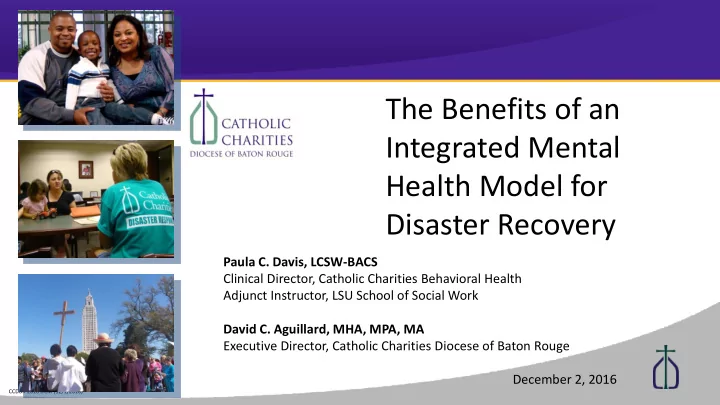

The Benefits of an Integrated Mental Health Model for Disaster Recovery Paula C. Davis, LCSW-BACS Clinical Director, Catholic Charities Behavioral Health Adjunct Instructor, LSU School of Social Work David C. Aguillard, MHA, MPA, MA Executive Director, Catholic Charities Diocese of Baton Rouge December 2, 2016 CCDBR 2016 DCM (12/1/2016)
CCDBR DR Experience Hurricanes, tornadoes, wild fires, oil spills and even ice storms and a tsunami. Lead agency post-Katrina Pilot project following Gustav DR after Isaac Helped start the DCM program in NY after Superstorm Sandy. Assisted agencies in Boston, Joplin, Birmingham and Oklahoma, among other locations. CCDBR 2016 DCM (12/1/2016)
CCDBR DCM Timelines Hurricane 5 months DCM Begins 23 months 1,900 HH Enrolled Katrina Hurricane Isaac 8 months DCM Begins 23 months 450 HHs Enrolled March 2016 2 months DCM Begins 4 Months 263 HHs Enrolled Flood August 2016 Immediately DCM Begins 3 Months 2,137 HHs Enrolled Flood CCDBR 2016 DCM (12/1/2016)
HHs Served by CCDBR Disaster Operations in 2016 • 19,266 Households $70k in transportation, appliances, return to work, utilities, housing CCDBR 2016 DCM (12/1/2016)
CCDBR DCM HHs CCDBR 2016 DCM (12/1/2016)
CCDBR DCM HoH Demographics CCDBR 2016 DCM (12/1/2016)
CCDBR DCM HoH Demographics Ethnicity: Hispanic 4% CCDBR 2016 DCM (12/1/2016)
CCDBR DCM Household Income Levels <$24,300 for a family of 4 FY2016 HUD Metropolitan FMR Area's Income Limits CCDBR 2016 DCM (12/1/2016)
Disaster Syndrome 1/3 of survivors will develop some type of post-disaster disorder – Depression, PTSD, social isolation, adjustment disorders, inability to concentrate, sleeplessness, substance abuse, domestic violence Leaves long-term psychological scars. Successive disasters can have cumulative effects. CCDBR 2016 DCM (12/1/2016)
Current FEMA Model Existing Recovery Categories of Need 1. Animal Assistance 13. Housing 2. Appliances 14. Job Training 3. Benefits 15. Legal 4. Children and Youth Services 16. Medical Assistance 5. Clothing 17. Missing Person 6. Emotional/Spiritual Care 18. Mold Remediation 7. Employment 19. Other 8. Food & Nutrition 20. Repair and Rebuild 9. Functional Needs 21. Transportation 10. Funeral Assistance 22. Utilities 11. Furniture 12. Household Goods CCDBR 2016 DCM (12/1/2016)
Post-Disaster Mental Health A study following the BP oil spill found that more than one year later: La. Post Disaster Mental Health Study Participants National Norms 40% 35% 33% 35% 28% 30% 25% 18% 20% 15% 15% 10% 10% 6% 4% 5% 0% Serious Mental Depression Anxiety Post traumatic Illness stress Source: LSU Health Sciences Center – New Orleans CCDBR 2016 DCM (12/1/2016)
Social Cost of Unresolved MH Half of BP study reported disturbed family and work Following a disaster, stress and loss of support systems increases public health problems. • Tobacco Use • Alcohol and Substance Abuse • Domestic Violence • Child Abuse & Neglect Obstacles to Recovery DCM Population Unlikely to Access Services CCDBR 2016 DCM (12/1/2016)
CCDBR DCM Demographics CCDBR 2016 DCM (12/1/2016)
Integrated Disaster Recovery Solution: Integrated Mental Health Current FEMA Model integrated Construction Supervision into Recovery Teams Recommendation • Clinical Supervisor • 1 Licensed Mental Health Professional per team CCDBR 2016 DCM (12/1/2016)
Benefits of Integrated Model Accessible Non-Stigmatizing part of the program “Warm Referrals” Builds on Natural Support Systems Includes Entire Family Pre- & Post-Testing to Demonstrate Impact Screener developed with LSU Health Sciences Center and The Bridge Center Prevention Holistic Builds Resilient Families CCDBR 2016 DCM (12/1/2016)
Cost -- Benefit Integrated Teams of 10 LPCs and 1 Clinical Supervisor - about $1 million – to serve about 10K Households within CCDBR Structure Stand alone - >$2 million $1 spent on MH treatment returns • $7.00 economic benefit (increased productivity, decreased absenteeism) • $7.14 health cost savings • $3.68 in reduced criminal activity CCDBR 2016 DCM (12/1/2016)
Recommendations for the Task Force 1. Future Recommendation: FEMA funding of long term recovery to include integrated mental health. 2. Current Opportunity: SSBG if awarded, use for integrated mental health services for the 2016 floods. CCDBR 2016 DCM (12/1/2016)
CCDBR 2016 DCM (12/1/2016)
Recommend
More recommend